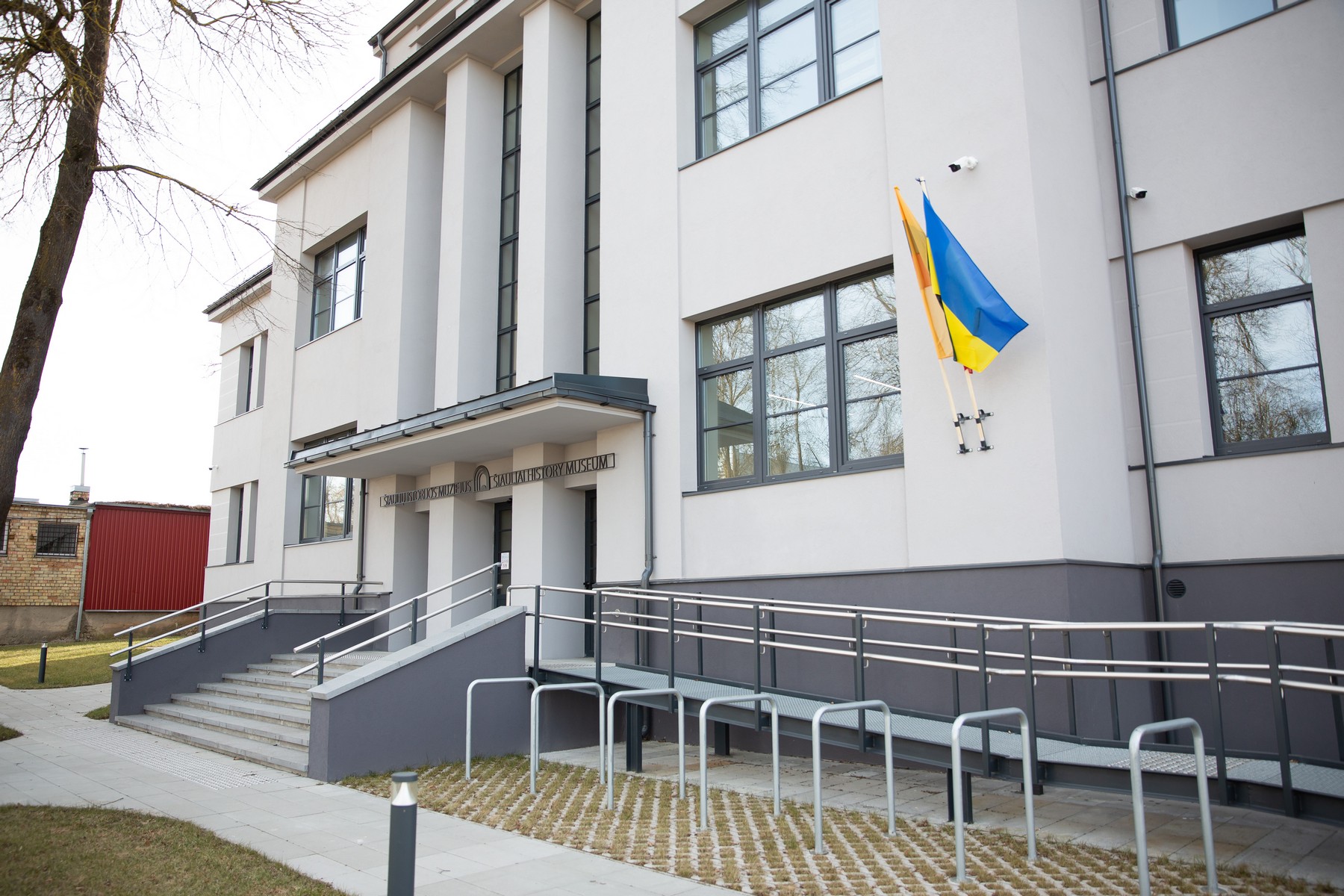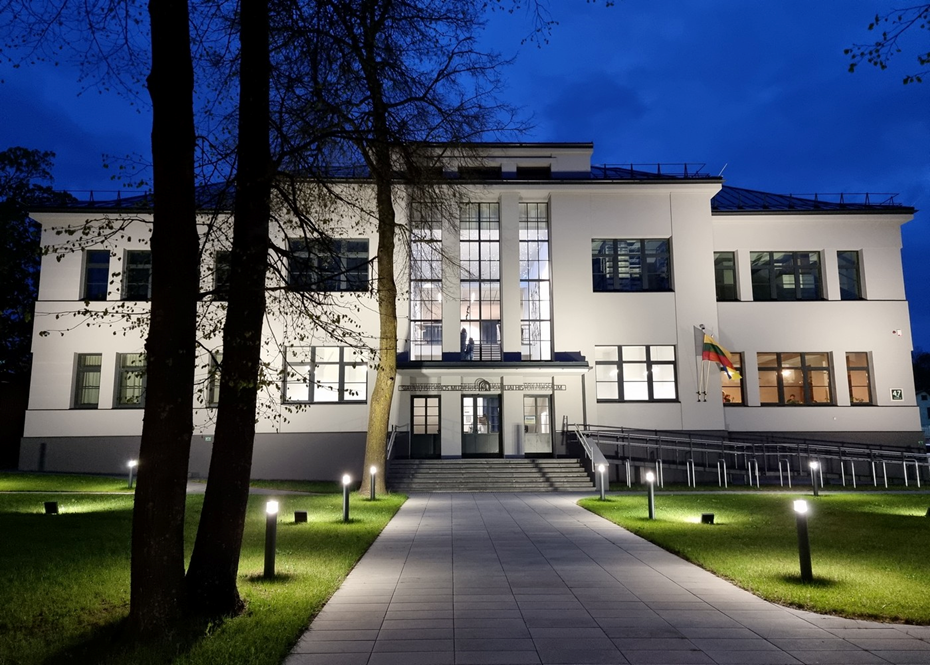
Subdivisions
- Home
- SUBDIVISIONS
- Šiauliai History Museum
Šiauliai History Museum

2019 The reconstruction project of the building, financed by the EU Regional Development Funds and the state budget of the Republic of Lithuania, was launched. 2021 the building was completed for reconstruction in 2022. it is planned to set up an exposition of Šiauliai History Museum.
The new museum will have modern and contemporary archeology, historical expositions and open repositories, which will allow you to present a large collection of the most valuable exhibits. It will organically combine original exhibits and reconstructions, and the information will be presented on several levels, adapting to the needs of the visitor. The context of the expositions will be expanded by the educational space and outdoor exposition. An exhibition-event hall will also be dedicated to multifunctional museum activities. The museum is equipped with a ramp, elevator and toilet for the disabled.
Aušros al. 47, Šiauliai
Phone +370 41 52 43 86
Email info@ausrosmuziejus.lt
Website www.ausrosmuziejus.lt
Tue, Thur, Fri 10 am–6 pm
Wed 10 am–6 pm
Sat–Sun 11 am–5 pm
The Park is open for free I–VII 10 am–10 pm
A History of the Building
On January 7, 1928, Šiauliai Regional Society took over “Aušros” museum from Šiauliai County Board. During ethnographic expeditions and archaeological explorations, many museum values were collected. As the activities of the museum were expanding, there was a lack of space, and the building on the then Maišo (now S. Nėries) street was not suitable for museum activities, thus in 1930, it was decided to build a museum building. The Committee for the Museum and Library Construction was formed. The building was to be built in the park, next to the palace of Counts Zubovai. The newly elected Šiauliai City Council stopped the construction that had started, due to a lack of funds. The building in Aušros avenue according to the project of architect Vladas Bitė in 1932 was built as a primary school. After long negotiations, the museum moved here a year later, after the construction of the Museum and Library Building designed by architect Karolis Reisonas was stopped. There was the school in the basement and on the first floor, the museum was equipped on the second floor and in the attic. The museum was given over to Šiauliai City Municipality, and the Regional Society was only responsible for the museum. A new museum exposition was installed, it was divided into divisions – archaeology, ethnography, history, nature and art – and it was opened on May 14, 1933. The exhibitions were organized in the museum: “The Exhibition of 1863 Uprising” (1933), “The Exhibition of the Ancient Book” (1934), “The Exhibition of Ancient Art” (1936), “The Exhibition of Vilnius” (1939) and others. Lectures were read during exhibitions. After the exhibitions ended, a number of museum valuables donated by their participants remained in the museum. The museum was open even at the beginning of the Second World War, until 1943, when the German occupation authorities ordered the evacuation and established a military hospital in the building. The building was badly burned during the bombing. In 1966, the building was returned to Šiauliai “Aušros” museum and the Ethnography Division was established in it. Until 1976, the exhibitions were held here, and in 1978, the History and Ethnography Exposition was opened. In 1990, after the restoration of Lithuania’s independence, in 1991 – 1992, the exposition was updated. Instead of the monographic exposition with ideological nature of the 20th c. Lithuanian history, the basis of which was the implementation of the Communist Party’s policy, three new expositions were prepared: “Lithuania and Šiauliai Region 1918 – 1940” (authors Eugenija Raguckienė and Irena Nekrašienė), “Revival” and “Repressions in 1941 – 1953” (authors Birutė Lukošiūtė, Aurelija Malinauskaitė, and Jonas Ziemelis). In addition, the themes of archaeology, ethnography and history were separated, which had been developed in parallel in the old exposition. The rearranged ethnographic exhibition “The Craft of Flax and Weaving” was named “Peasants’ Household and Daily Life” (authors Skaistė Mockutė and Regina Tamašiūnaitė). And only in 2004, the archaeology exposition “The Past of Šiauliai Region from the Ancient Times to the 17th Century” was updated and expanded (authors Audronė Šapaitė, Virginija Ostašenkovienė, and Birutė Salatkienė). In 1999, on the first floor, the first educational room “The House of Old Crafts” was installed, which marked the beginning of the museum’s active educational activities. Educational activities were held there for the students: “Pot Moulding in the Ancient Ways”, “Banding with Brass Plates”, “Ancient School and Writing Room” and others. In autumn of 2012, an educational class of the interwar school was installed. In 2013, this division of the museum was called the Education Centre. Later, due to the poor condition of the premises, the exhibition hall was closed, and part of the exhibition halls became repositories for collections. In 2019 – 2023, the project “Reconstruction of education centre building of Šiauliai “Aušros” museum” was implemented, which was financed by the European Regional Development Fund and the state budget of the Republic of Lithuania. Now Šiauliai History Museum has been established there, and modern and contemporary expositions have been created. The exposition presents the past of Šiauliai from ancient times to the First World War. The original museum values, their digital copies and reconstructions are displayed in the museum. The content of the exhibition is complemented by material presented on virtual terminals and screens. The museum has a novelty in Lithuania – the Open Repositories Exposition, which presents the museum’s “Gold Fund” – the most significant museum values of the ethnography and art divisions. The museum visitors can see the museum values which have been collected since the foundation of the museum in 1923 till nowadays, illustrating the history of “Aušros” museum. The museum building houses the divisions of the records of Šiauliai history expositions and museum values and collections of Šiauliai region, as well as an exhibition-event hall dedicated to multifunctional museum activities, educational space and outdoor exposition.

In 1933, Šiauliai “Aušros” museum was located on the second floor and attic of the building designed by architect Vladas Bitė. Photographer Peliksas Bugailiškis.

The buildings of primary school and “Aušros” museum, Aušros alley 47, Šiauliai. Unknown photographer, 4th decade of the 20th century.

 Chaimas Frenkelis Villa-Museum
Chaimas Frenkelis Villa-Museum
 Venclauskiai House-Museum
Venclauskiai House-Museum
 Šiauliai History Museum
Šiauliai History Museum
 Photography Museum
Photography Museum
 Bicycle Museum
Bicycle Museum
 Radio and Television Museum
Radio and Television Museum
 Žaliūkiai Village Miller’s Farmstead-Museum
Žaliūkiai Village Miller’s Farmstead-Museum